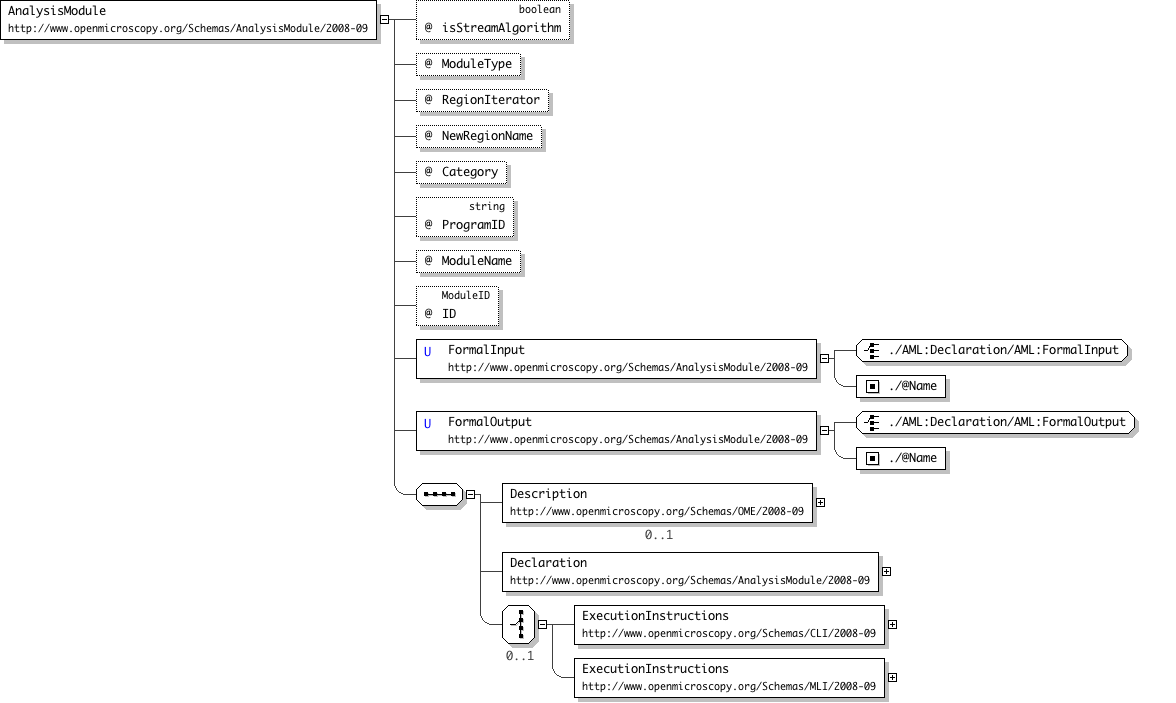
| Target Namespace | http://www.openmicroscopy.org/Schemas/AnalysisModule/2008-09 |
|---|---|
| Version | 1 |
| Element and Attribute Namespaces |
|
| Schema Composition |
|
| Prefix | Namespace |
|---|---|
| xml | http://www.w3.org/XML/1998/namespace |
| AML | http://www.openmicroscopy.org/Schemas/AnalysisModule/2008-09 |
| CLI | http://www.openmicroscopy.org/Schemas/CLI/2008-09 |
| Bin | http://www.openmicroscopy.org/Schemas/BinaryFile/2008-09 |
| MLI | http://www.openmicroscopy.org/Schemas/MLI/2008-09 |
| OME | http://www.openmicroscopy.org/Schemas/OME/2008-09 |
| xsd | http://www.w3.org/2001/XMLSchema |
| Name | AnalysisModule |
|---|---|
| Used by (from the same schema document) | Element AnalysisModuleLibrary |
| Type | Locally-defined complex type |
| Nillable | no |
| Abstract | no |
| Documentation | Describes an interface to use with a program. |

'This is a stub for future development. The database location doesn\'t even exist yet. If the output of the analysis will be the same when pixel positions are scrambled, the analysis is a stream algorithm. Examples of stream algorithms are: A statistics module that produces mean, geometric mean, standard deviation, etc. for pixel intensities. A module to cross correlate pixel intensities across wavelengths. Example of an algorithms that is not a stream algorithm is: FindSpots. (It\'s a module to find blobs in an image.) If a module is a stream algorithm, it can function across the x, y, z, and time dimensions. Tied to DB. Table PROGRAMS Column IS_STREAM_ALGORITHM'
"'As more handlers, are added, this part of the schema needs to be changed Tied to DB. Table PROGRAMS Column MODULE_TYPE'
"'If the module iterates over a region, specify the iterator here. It will reference a region via the TAG column of the REGIONS table. An example of a module that does not iterate over a region is Find Cells. It examines one image at a time, hence it iterates over an image, not a region. It produces zero or more regions (Çell) per image. These Cell regions belong to an image. This module would not get a RegionIterator attribute. An example of a module that iterates over a region is Find Golgi. It examines one CELL at a time. A cell is a region, hence the module iterates over regions, not images or datasets. It produces zero or more Golgi regions per Cell region. These Golgi regions belong to a Cell region. This module would get a RegionIterator attribute of \"CELL\". Tied to DB. Table PROGRAMS Column DEFAULT_ITERATOR'
"'If this module makes new regions, then the new Region\'s name needs to be specified here. If the module does not make new regions, do not specify a value for this attribute. Tied to DB. PROGRAMS.NEW_FEATURE_TAG'
"'References a Category.'
"'Eventually will refer to a program. Currently program installation is NOT implemented. So this value is the path to the installed binary file.'
"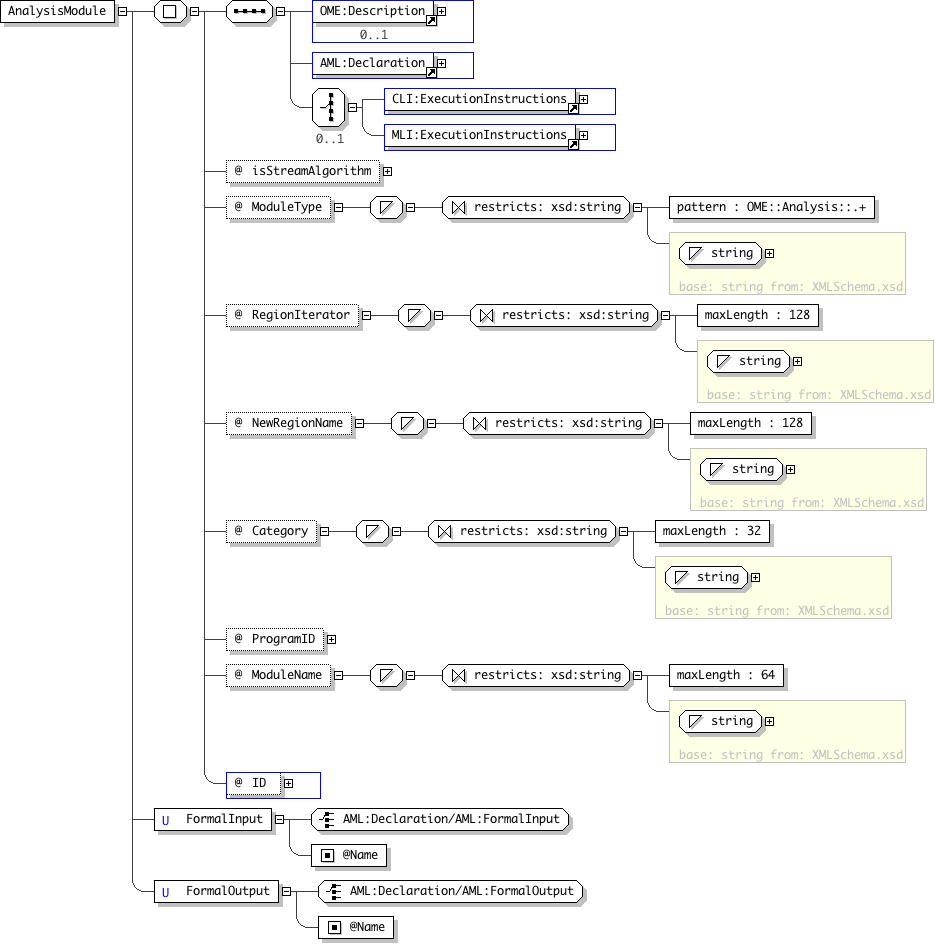
| Name | AnalysisModuleLibrary |
|---|---|
| Type | Locally-defined complex type |
| Nillable | no |
| Abstract | no |
| Documentation | An analysis module is defined by two things: 1) A program 2) An interface A single program may have multiple interfaces. Why do you need multiple interfaces? Pretend you have a program that calculates simple statistics on the pixels of an image. You can specify which statistics you want via parameters. Typing ./stats -mean -sigma image1 will output Image | mean | sigma image1 12.4 1 Typing ./stats -geomean -mean image1 will output Image | geomean | mean image1 12.2 12.4 The outputs are completely different. You need to specify an interface for each of these behaviors. Or pretend you have a powerful program that can do 10 unrelated tasks, each of which outputs an image. While the outputs are the same type and format, they represent 10 completely different things. In this case, it might make sense to define 10 corresponding AnalysisModule to represent the 10 logical functions. In any case, use AnalysisModule to define an interface and Program to store installation software for a program. |

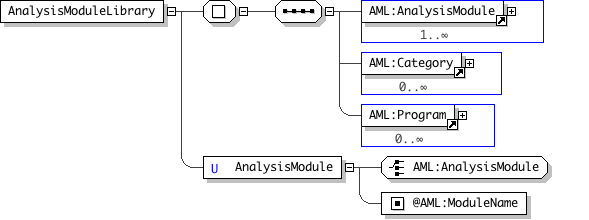
| Name | Category |
|---|---|
| Used by (from the same schema document) | Element AnalysisModuleLibrary |
| Type | Locally-defined complex type |
| Nillable | no |
| Abstract | no |

'Categories are organized into hierarchical structures. This specifies the full path of this category in the following format. Path = \"GrandParent name.Parent name.Category name\" If you defined a sub category, we Strongly encourage you to also define all ancestor categories that are not part of the core OME specification.'
">
| Name | Declaration |
|---|---|
| Used by (from the same schema document) | Element AnalysisModule |
| Type | Locally-defined complex type |
| Nillable | no |
| Abstract | no |
| Documentation | States module requirements. Formal Inputs are optional because input requirements may be specified by guaranteed image attributes. For example, OME_Image_XYZ_stats requires a path to the OME repository file, and Dimensions. These are given by <RawImageFilePath>, <sizeX>, <sizeY>, <sizeZ>, <sizeT>, and <sizeW>. |


| Name | Entry |
|---|---|
| Used by (from the same schema document) | Element LookupTable |
| Type | Locally-defined complex type |
| Nillable | no |
| Abstract | no |


| Name | FormalInput |
|---|---|
| Used by (from the same schema document) | Element Declaration |
| Type | Locally-defined complex type |
| Nillable | no |
| Abstract | no |
| Documentation | Specifies an input requirement for a module. Image dimensions and image file locations (repository or other format) should not be specified with this. Image dimensions are intrinsic to an image. They do not represent a special requirement. Image file locations and contents are specified by other elements. Specifically, RawImageFile, RawImageFilePath, XYPlaneFile, and XYPlaneFilePath. |
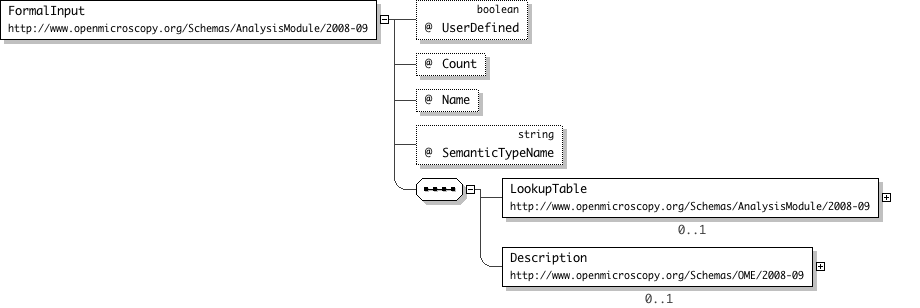
'OME interprets this as a recommendation rather than a requirement. Tied to DB. Table FORMAL_INPUTS Column USER_DEFINED'
"'Specifies how many counts of this formal input are expected. Meanings are specified below ! = exactly one ? = zero or one + = one or more * = zero or more'
"'Valid characters are alphanumeric and spaces.'
"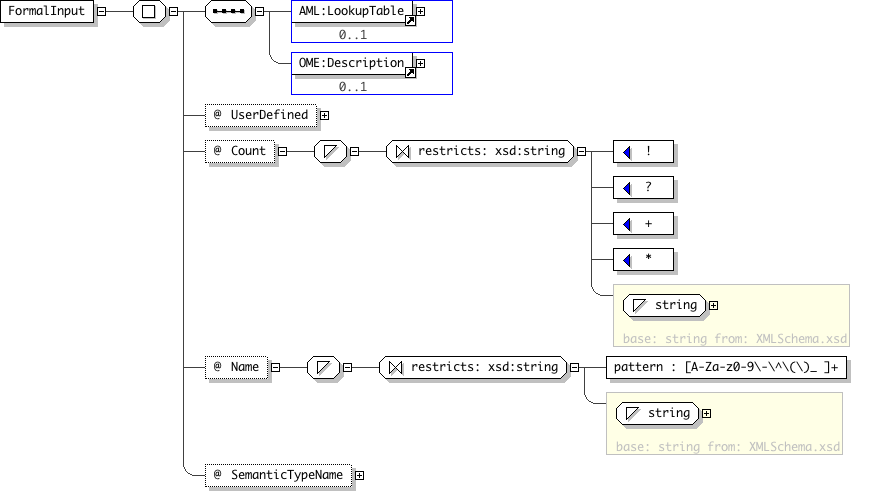
| Name | FormalOutput |
|---|---|
| Used by (from the same schema document) | Element Declaration |
| Type | Locally-defined complex type |
| Nillable | no |
| Abstract | no |
| Documentation | Specifies an output element of a module. |

'Concerning MakeNewRegion attribute of ExecutionInstructions, if a new region type is made, then there are two possible places a formal output attribute can be stored: It can be stored as an attribute of the RegionIterator, or it can be stored as an attribute of the new Region. This tag is supposed to specify which. Can be left blank if module does not make new iterator. Tied to DB. FORMAL_OUTPUTS.FEATURE_TAG Processed before storage to DB'
"'Specifies how many counts of this formal output will be produced. Meanings are specified below ! = exactly one ? = zero or one + = one or more * = zero or more'
"'THIS IS REQUIRED for every formal output outside of the importer. The importer doesn\'t know what it will run into before it executes, so it can\'t declare the semantic type of its outputs. If you are writing a module, I HIGHLY HIGHLY recommend that you type your formal outputs.'
">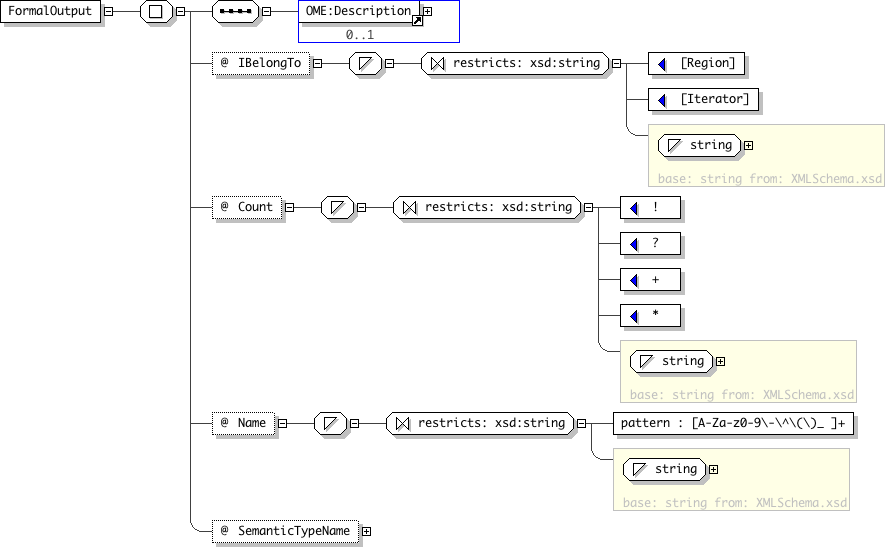
| Name | InstallationFile |
|---|---|
| Used by (from the same schema document) | Element Program |
| Type | Locally-defined complex type |
| Nillable | no |
| Abstract | no |
| Documentation | Contains a packaged or zipped installation files (binaries or source code). |


| Name | InstallationScript |
|---|---|
| Used by (from the same schema document) | Element Program |
| Type | Locally-defined complex type |
| Nillable | no |
| Abstract | no |
| Documentation | The script should interface with the OME API to find all information it needs. (i.e. installation path) It also needs to set the location of the program after the program is installed. The location should be set through the API, but it will propagate to the LOCATION column of the PROGRAMS table. |


| Name | Installed |
|---|---|
| Used by (from the same schema document) | Element Program |
| Type | Locally-defined complex type |
| Nillable | no |
| Abstract | no |


| Name | LookupTable |
|---|---|
| Used by (from the same schema document) | Element FormalInput |
| Type | Locally-defined complex type |
| Nillable | no |
| Abstract | no |
| Documentation | Describes valid values for an input. Think enumerations, (a list of valid values). |


| Name | Program |
|---|---|
| Used by (from the same schema document) | Element AnalysisModuleLibrary |
| Type | Locally-defined complex type |
| Nillable | no |
| Abstract | no |
| Documentation | Stores an installation package and installation script for a program. This currently is NOT implemented. |

'Program name. Unclear how this would be used. DB location PROGRAMS.PROGRAM_NAME is populated by XML attribute AnalysisModule.Name.'
"'Currently unused'
"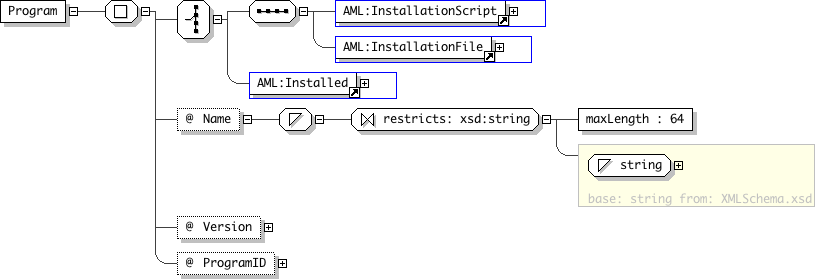
| Super-types: | xsd:hexBinary < Hex40 (by restriction) |
|---|---|
| Sub-types: | None |
| Name | Hex40 |
|---|---|
| Content |
|

| Super-types: | OME:LSID < ModuleID (by restriction) |
|---|---|
| Sub-types: | None |
| Name | ModuleID |
|---|---|
| Used by (from the same schema document) | Element AnalysisModule |
| Content |
|

| Super-types: | Address < AusAddress (by extension) |
|---|---|
| Sub-types: |
|
| Name | AusAddress |
|---|---|
| Abstract | no |
The XML Instance Representation table above shows the schema component's content as an XML instance.
Abstract (Applies to complex type definitions and element declarations). An abstract element or complex type cannot used to validate an element instance. If there is a reference to an abstract element, only element declarations that can substitute the abstract element can be used to validate the instance. For references to abstract type definitions, only derived types can be used.
All Model Group Child elements can be provided in any order in instances. See: http://www.w3.org/TR/xmlschema-1/#element-all.
Choice Model Group Only one from the list of child elements and model groups can be provided in instances. See: http://www.w3.org/TR/xmlschema-1/#element-choice.
Collapse Whitespace Policy Replace tab, line feed, and carriage return characters with space character (Unicode character 32). Then, collapse contiguous sequences of space characters into single space character, and remove leading and trailing space characters.
Disallowed Substitutions
(Applies to element declarations). If substitution is specified, then substitution group members cannot be used in place of the given element declaration to validate element instances. If derivation methods, e.g. extension, restriction, are specified, then the given element declaration will not validate element instances that have types derived from the element declaration's type using the specified derivation methods. Normally, element instances can override their declaration's type by specifying an xsi:type attribute.
Key Constraint Like Uniqueness Constraint, but additionally requires that the specified value(s) must be provided. See: http://www.w3.org/TR/xmlschema-1/#cIdentity-constraint_Definitions.
Key Reference Constraint Ensures that the specified value(s) must match value(s) from a Key Constraint or Uniqueness Constraint. See: http://www.w3.org/TR/xmlschema-1/#cIdentity-constraint_Definitions.
Model Group Groups together element content, specifying the order in which the element content can occur and the number of times the group of element content may be repeated. See: http://www.w3.org/TR/xmlschema-1/#Model_Groups.
Nillable
(Applies to element declarations). If an element declaration is nillable, instances can use the xsi:nil attribute. The xsi:nil attribute is the boolean attribute, nil, from the http://www.w3.org/2001/XMLSchema-instance namespace. If an element instance has an xsi:nil attribute set to true, it can be left empty, even though its element declaration may have required content.
Notation A notation is used to identify the format of a piece of data. Values of elements and attributes that are of type, NOTATION, must come from the names of declared notations. See: http://www.w3.org/TR/xmlschema-1/#cNotation_Declarations.
Preserve Whitespace Policy Preserve whitespaces exactly as they appear in instances.
Prohibited Derivations (Applies to type definitions). Derivation methods that cannot be used to create sub-types from a given type definition.
Prohibited Substitutions (Applies to complex type definitions). Prevents sub-types that have been derived using the specified derivation methods from validating element instances in place of the given type definition.
Replace Whitespace Policy Replace tab, line feed, and carriage return characters with space character (Unicode character 32).
Sequence Model Group Child elements and model groups must be provided in the specified order in instances. See: http://www.w3.org/TR/xmlschema-1/#element-sequence.
Substitution Group Elements that are members of a substitution group can be used wherever the head element of the substitution group is referenced.
Substitution Group Exclusions (Applies to element declarations). Prohibits element declarations from nominating themselves as being able to substitute a given element declaration, if they have types that are derived from the original element's type using the specified derivation methods.
Target Namespace The target namespace identifies the namespace that components in this schema belongs to. If no target namespace is provided, then the schema components do not belong to any namespace.
Uniqueness Constraint Ensures uniqueness of an element/attribute value, or a combination of values, within a specified scope. See: http://www.w3.org/TR/xmlschema-1/#cIdentity-constraint_Definitions.